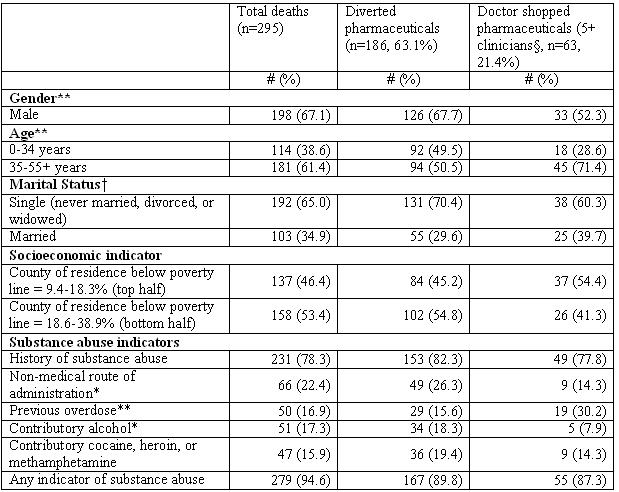Some prescribed medications, such as opioid analgesics, are commonly objects of dependency and abuse (e.g., Martins, Ghandour, & Chilcoat, 2007). People who abuse controlled pharmaceuticals can obtain extra medication by doctor shopping or by diverting the medication from other sources. This week’s STASH reports on a study about the demographics, histories of substance abuse, and drug prescription records from people dying of unintentional pharmaceutical overdose in West Virginia in 2006.
Method:
Hall, Logan, Toblin, Kaplan, Kraner et al. (2008) reviewed public and medical records to obtain data.
- The deceased persons’ medical records provided information about their substance abuse behaviors and any past suicide attempts.
- The Controlled Substance Monitoring Program reported the deceased persons’ prescription history, the number of their prescribing doctors, and the number of prescribing pharmacies they used.
- The Office of the Chief Medical Examiner combined this information with toxicology reports, police reports, and interviews with surviving friends and family to determine demographic information about the deceased, the contributing causes of death, death intentionality (e.g., intentional or accidental), and whether markers of substance abuse were associated with the death.
- Because the study could not use self report, the researchers used proxies of substance abuse indicators such as history of substance abuse, presence of other controlled contributory substances, and evidence of non-medical route of medication administration.
Results:
- In West Virginia, 295 unintentional pharmaceutical overdosed deaths were identified during 2006.
- More people diverted than doctor shopped (186 vs 63); only 24 people (8.1%) did both. The authors did not categorize 46 people from the sample as either doctor shoppers or diverters.
- Table 1 shows more men than women unintentionally overdosed, however, about an equal number of men and women doctor shopped.
- Higher rates of people who diverted were younger and male compared with people who doctor shopped. Both groups were highly likely to have indicators of substance abuse, although more doctor shoppers had previous overdoses in their medical histories (see Table 1).

Figure. Characteristics of people who divert and doctor shop among unintentional pharmaceutical overdose deaths. Adapted from Hall et al (2008); statistical significance testing added. §Includes only clinicians who prescribed controlled medications during the past year to the person who overdosed. †Marital status among people over age 25. *p=.05; **p<.05 Indicates a statistical difference between people who diverted and people who doctor shopped according to chi-square test. Click image to enlarge.
Limitations
- Death intentionality relied on opinions from the Chief Medical Examiner’s office and therefore might not be accurate – death records could reflect a desire to protect the reputation of the deceased, or to help the deceased’s family obtain life insurance payments. Therefore this sample might include some people who intentionally committed suicide.
- It is difficult to determine the full substance abuse history and the intentionality of the death because of limited data.
- The extent of substance abuse and previous drug overdoses and other measures likely are underestimates because friends and family members might have report inaccurate information and there likely is missing or erroneous information available to them.
Conclusion
Examining these demographic background and substance abuse indicators can help prescribers identify people who obtain extra medication, ultimately preventing overdose. More information, such as this sample’s health and mental health status, as well their methods for gaining additional medication, also could help prescribers prevent overdose.
What do you think? Please use the comment link below to provide feedback on this article.
References
Hall, A. J., Logan, J. E., Toblin, R. L., Kaplan, J. A., Kraner, J. C.,
Bixler, D., et al. (2008). Patterns of abuse among unintentional pharmaceutical overdose fatalities. Journal of the American Medical Association, 300(22), 2613-2620.
Martins, S. S., Ghandour, L. A., & Chilcoat, H. D. (2007). Profile of dependence symptoms among extramedical opioid analegesic users. Addictive Behaviors, 32(10), 2003-2019.




